DISCOVER NEW HORIZONS
C/2025 A6 (Lemmon)
-
Imaging Camera QHY600
-
Total Integration 12min
L: 450sec
R: 90sec
G: 90sec
B: 90sec
DISCOVER NEW HORIZONS
L: 450sec
R: 90sec
G: 90sec
B: 90sec
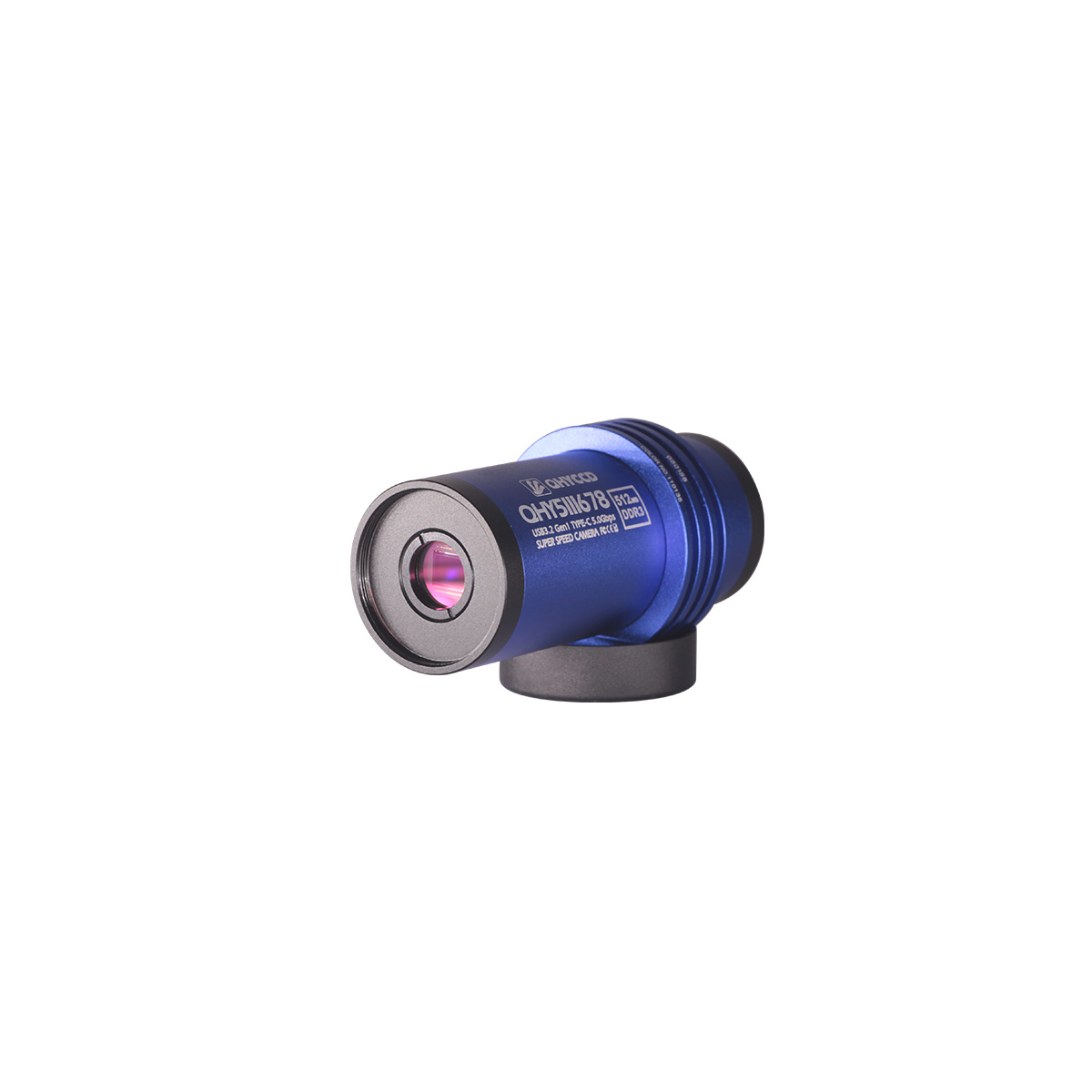
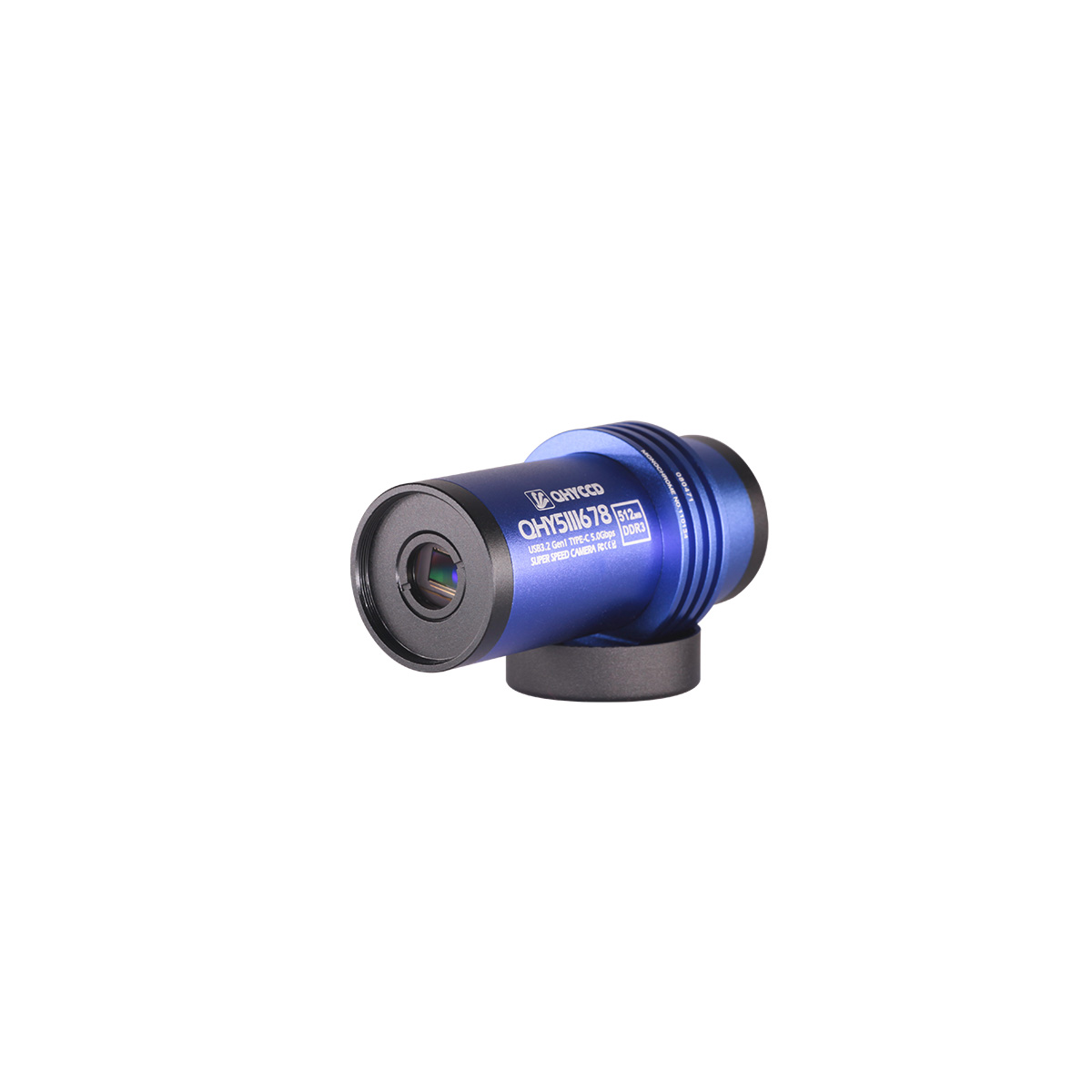
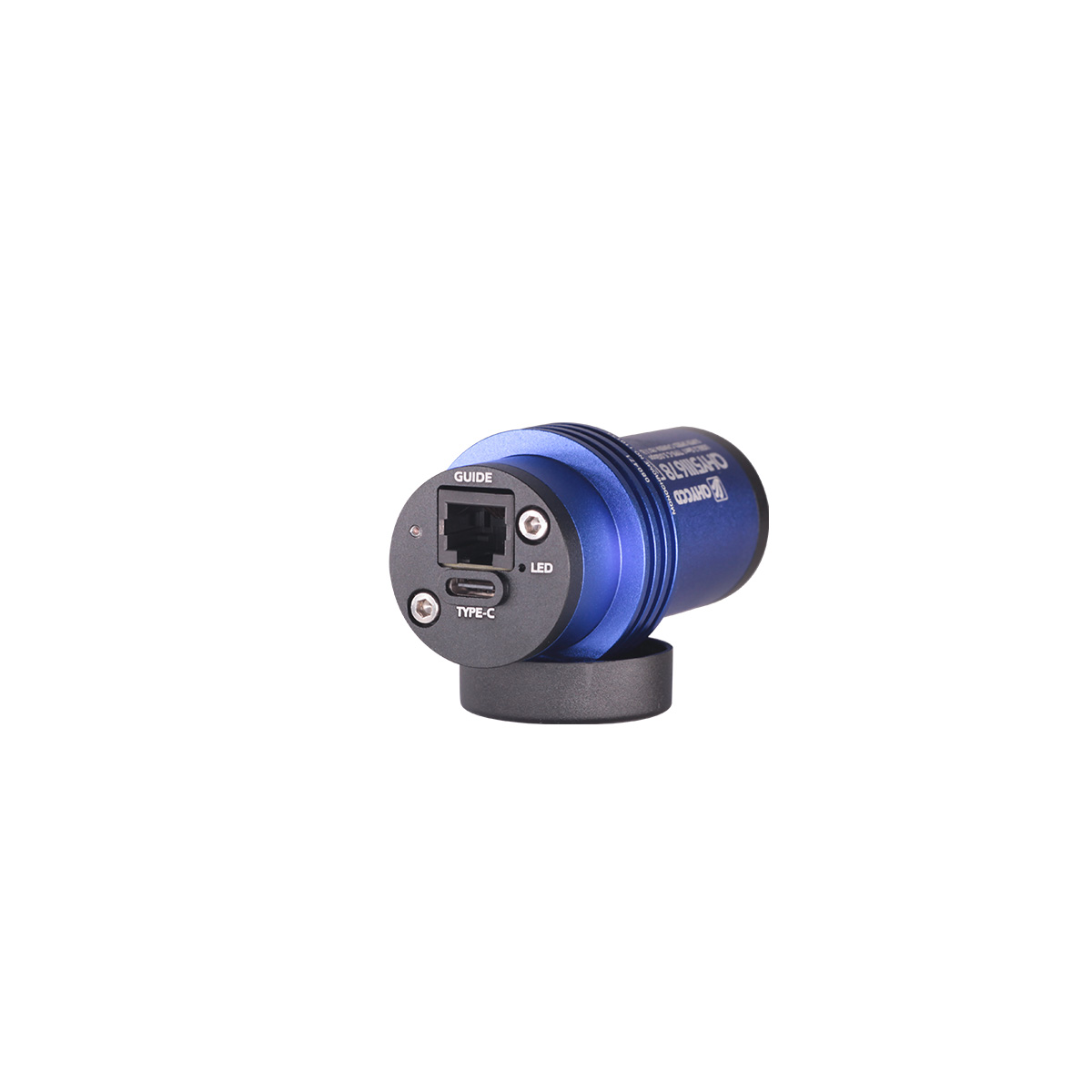
| Model | Regular Retail Price* | Retail Price for the U.S. |
| QHY5III678M | $349 | $384 |
| QHY5III678C | $299 | $329 |
QHY5III678M/C, the upgraded version of QHY5III 178M/C, is a new planetary and guiding camera of QHY5III V2 series with excellent near-infrared high sensitivity. The product comes with an IR850 filter.
*Price shall be slightly different among countries and regions; Shipment expenses, customs or other taxes are not included.
In this latest generation of sensors, the photodiode portion of the pixel well is physically deeper than in previous sensors, allowing photons of longer wavelengths to penetrate deeper into the substrate. This dramatically increases the sensor’s sensitivity to red and near-infrared (NIR) light. The sensor displays almost equal peak sensitivity to NIR light as it does to light in the visible spectrum.
The QHY5III (Ver. 2) series planetary and guiding cameras are all equipped with a 512MB DDR3 image buffer which can effectively reduce the pressure on computer transmission, a great help for planetary photography which often requires writing a large amount of data in a short period of time. Some deep-sky astrophotography cameras on the market today only have 256MB, for example.
In comparison, the 512MB DDR3 memory of the new 5III (Ver. 2) series cameras represents a significant upgrade.
QHY5III (Ver. 2) series cameras have adopted a new front-end design with better compatibility.Here we only take QHY5III200M as example, however, ALL V2 cams in the future share these features.
The BFL of V2 cam is only 8mm, which means you can easily compat a V2 cam with your OAG. The basic top adapter includes 1.25 inch threads and you can still use your 1.25 inch filter.
The top adapter glass of V2 can be easily swiched. One of the adavantage of changable top glasses is you can use one filter even you’re using Lens! You can add a 1.25inch-cs adapter to connect CS lens, or add a second CS-C lens for C-mount lens. The two adapters are all standard accessories of V2 cams.
By the way, there’s a 1.25-inch filter wheel adapter to connect your mono planetary cam with the QHYCFW3-S filter wheel.
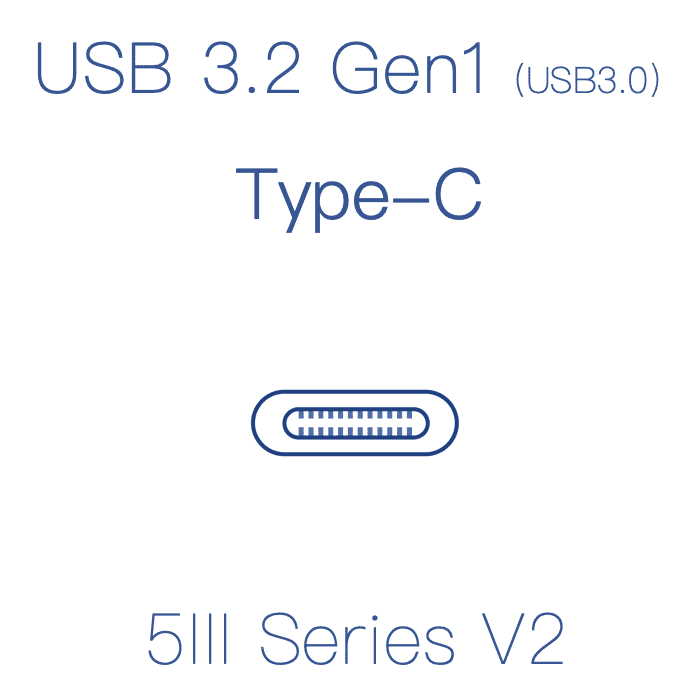 The new QHY5III (Ver.2) series cameras all use the USB3.2 Gen1 Type-C interface. Compared to the USB3.0 Type-B interface used in the previous generation, the Type-C interface has a longer life and is more flexible.
The new QHY5III (Ver.2) series cameras all use the USB3.2 Gen1 Type-C interface. Compared to the USB3.0 Type-B interface used in the previous generation, the Type-C interface has a longer life and is more flexible.
Tips: It is recommended to use the official standard Type-C data cable of QHYCCD. As the market is flooded with a large number of poor-quality Type-C cables, casual use may lead to the camera malfunctioning. If you use your own spare cable, please make sure it is a high-quality cable.
The custom interfaces of the previous generation of planetary cameras and guiders has been replaced in the QHY5III (Ver.2) cameras with a more universal ST-4 compatible guiding interface. Now, even if the guiding cable is lost or damaged, you will be able to easily get a replacement on the market at a low cost.
 The new QHY5III (Ver.2) series of cameras is equipped with a status indicator at the back of the camera. If the camera experiences an abnormal status, the multi-colored indicator light will help to determine the situation with different colors signifying different conditions. During normal operation this indicator light is off, so there is no worry about light contaminating the image.
The new QHY5III (Ver.2) series of cameras is equipped with a status indicator at the back of the camera. If the camera experiences an abnormal status, the multi-colored indicator light will help to determine the situation with different colors signifying different conditions. During normal operation this indicator light is off, so there is no worry about light contaminating the image.
| Model | QHY5III678M/C |
| Image Sensor | Sony IMX678 |
| Mono/Color | Both Available |
| FSI/BSI | BSI |
| Sensor Size | 1/1.8inch |
| Pixel Size | 2.0μm*2.0μm |
| Effective Pixel Area | 3856*2180 |
| Effective Pixels | 8.4 Megapixels |
| Full Well Capacity | 9ke- |
| Read Noise | 0.57e- to 3.3e- |
| A/D | 12-bit (output as 16-bit and 8-bit) |
| Built-in Image Buffer | 512MB DDR3 Memory |
| Full Frame Rates | 43FPS@8bit, 22FPS@16bit |
| ROI Frame Rates | 1080Lines, 85FPS@8bit, 43.5FPS@16bit 640Lines, 140FPS@8bit, 71FPS@16bit |
| Exposure Time Range | 11μs-900sec |
| Shutter Type | Electronic Rolling Shutter |
| Computer Interface | USB3.0 Type-C |
| Guide Port | Standard ST-4 Style |
| Telescope Interface | 1.25-inch, with CS and C-Mount |
| Optical Window | AR Anti-reflection Glass (5III678M) IR-Cut filter (5III678C) |
| Extra Filter | IR850nm Filter Included |
| Back Focal Length | 17mm (with adapter); 8mm(without adapter) |
| Weight | 90g |
Astrophotographer: Eduardo Schaberger Poupeau
Equipment: QHY5III678M, 60 mm Coronado SolarMax III double-stack
Jupiter and Saturn
Astrophotographer: Christopher Go
Equipment: QHY5III678M camera
Astrophotographer: Philippe Cambre
Equipment: QHY5III678M camera
By Luc Cathala
My name is Luc Cathala, I live in Mazan, a small village 30 km from Avignon, the city of the Popes in Vaucluse in France. I am 66 years old and have three children. Since I was a child, the night sky has always fascinated me. I bought astronomy magazines from time to time. In mid-December 2002 a friend lent me his Celestron 6. That night Saturn, Jupiter and the Moon were clearly visible, I was won over.
I bought a used C8 and modified a ToUcam Pro webcam to start taking photos.
In 2004 I acquired a second-hand 625 mm mirror. Being a technician, I manufactured the structure to support it in aluminum and steel. The production can be found in this post: https://www.webastro.net/forums/topic/10398-construction-t%C3%A9lescope-625-mm-%C3%A7a-continue/
In 2008, Jean-Marc Lecleire, one of the best French optical craftsmen, took over the mirror and increased its quality from lambda/2 to lambda/12. The secondary mirror with a small axis of 110 mm comes from Zen in Venice. Focal length 2730 mm.
I took the opportunity to build the equatorial platform which would allow me to access the photo. With a height of 95 mm, I have 1h20 of tracking before going back. It is powered by a “Picastro” developed by Arnaud Gérard, a brilliant electronics engineer who supplied kits.
I also made the shelter to put it in a fixed position allowing it to be operational in less than 5 minutes. The telescope can be put in a station wagon and reassembled in about twenty minutes. An airline pilot friend brought me a Point Gray Flea3 camera from Canada and I started taking lunar and planetary close-ups.
I live in the Rhône Valley in France, not far from Avignon, a place famous for its Mistral, a fairly violent wind circulating between the Massif Central and the Alps which limits the days of observations. My telescope, because of the focal length that I use up to 13650 mm, is very sensitive to high frequency turbulence caused by changes in the direction of air layers and mainly by the jet stream above 9000 m altitude. In addition to the planets, I photograph close-up lunar craters, in 2020 I was able to have those of Mars.
To combat turbulence I work a lot in infrared with the IR filters 610, 685, 742 and 807. Rarely in red and never in green. The days when conditions are extraordinary can be counted in the year on one hand.
In 2016 I bought a QHY5III178M. Its pixel count, sensitivity and USB3 were a clear improvement over the Flea3. In 2020 I bought a second-hand QHY5III178C which I use very little.
I was waiting for a more sensitive infrared camera and a colleague informed me of the release of the QHY5III678M V2. V1 required an external power supply which was unnecessary on V2.
I don’t know much about optics and sensors, so I’m just going to make a comparison in my area of use between the two cameras that are now at my disposal.
I use SharpCap 4.09562 software on an Asus GL703V 2.80 GHz laptop, 16 GB RAM, and 2 SSDs of 1 TB each. With this version of the software, the 678 is recognized immediately.
The camera arrives in a metal box, all the elements are blocked by quality foam. The accessories delivered allow you to be operational immediately.
 A quick comparison shows that the 178 is a little longer, the other dimensions are identical. Tube diameter 31.60 mm radiator diameter 40 mm. With the 31.75mm filter holders, the 678 is much shorter. The filter supports have a protective glass. That of the 178 is larger than that of the 678 (IR cut). With the 678 comes an IR 850 filter.
A quick comparison shows that the 178 is a little longer, the other dimensions are identical. Tube diameter 31.60 mm radiator diameter 40 mm. With the 31.75mm filter holders, the 678 is much shorter. The filter supports have a protective glass. That of the 178 is larger than that of the 678 (IR cut). With the 678 comes an IR 850 filter.
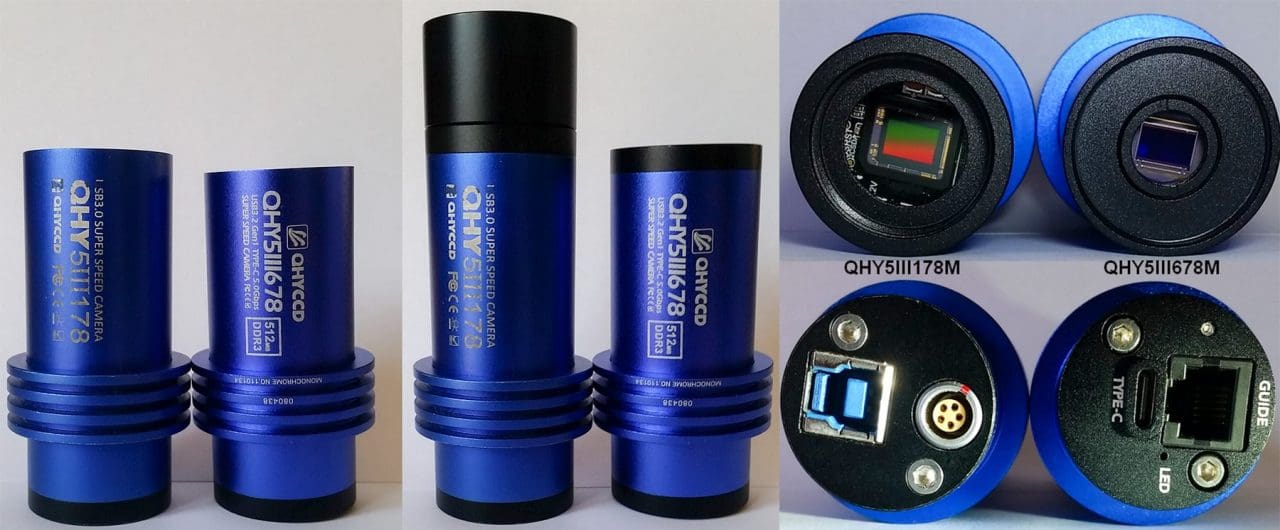 At the back, the USB-B 3.0 port of the 178 is replaced by a USB-C 3.2 Gen 1 on the 678. The supplied USB-C cable is 1.8 meters long, of excellent quality, and is more than sufficient even for my telescope because I stand next to it. The 178’s 5-pin LEMO auto guiding port becomes a more common ST-4 port, allowing the cable to be replaced easily if necessary. The 678 has an LED that gives indications depending on the color in the event of a problem but is normally turned off. In the event of a breakdown, providing the color to QHY will allow for long-term diagnosis, the other dimensions are identical. Tube diameter 31.60 mm radiator diameter 40 mm. With the 31.75mm portafilters, the 678 is much shorter. On the sensor side, the photo shows the differences in sizes and formats.
At the back, the USB-B 3.0 port of the 178 is replaced by a USB-C 3.2 Gen 1 on the 678. The supplied USB-C cable is 1.8 meters long, of excellent quality, and is more than sufficient even for my telescope because I stand next to it. The 178’s 5-pin LEMO auto guiding port becomes a more common ST-4 port, allowing the cable to be replaced easily if necessary. The 678 has an LED that gives indications depending on the color in the event of a problem but is normally turned off. In the event of a breakdown, providing the color to QHY will allow for long-term diagnosis, the other dimensions are identical. Tube diameter 31.60 mm radiator diameter 40 mm. With the 31.75mm portafilters, the 678 is much shorter. On the sensor side, the photo shows the differences in sizes and formats.
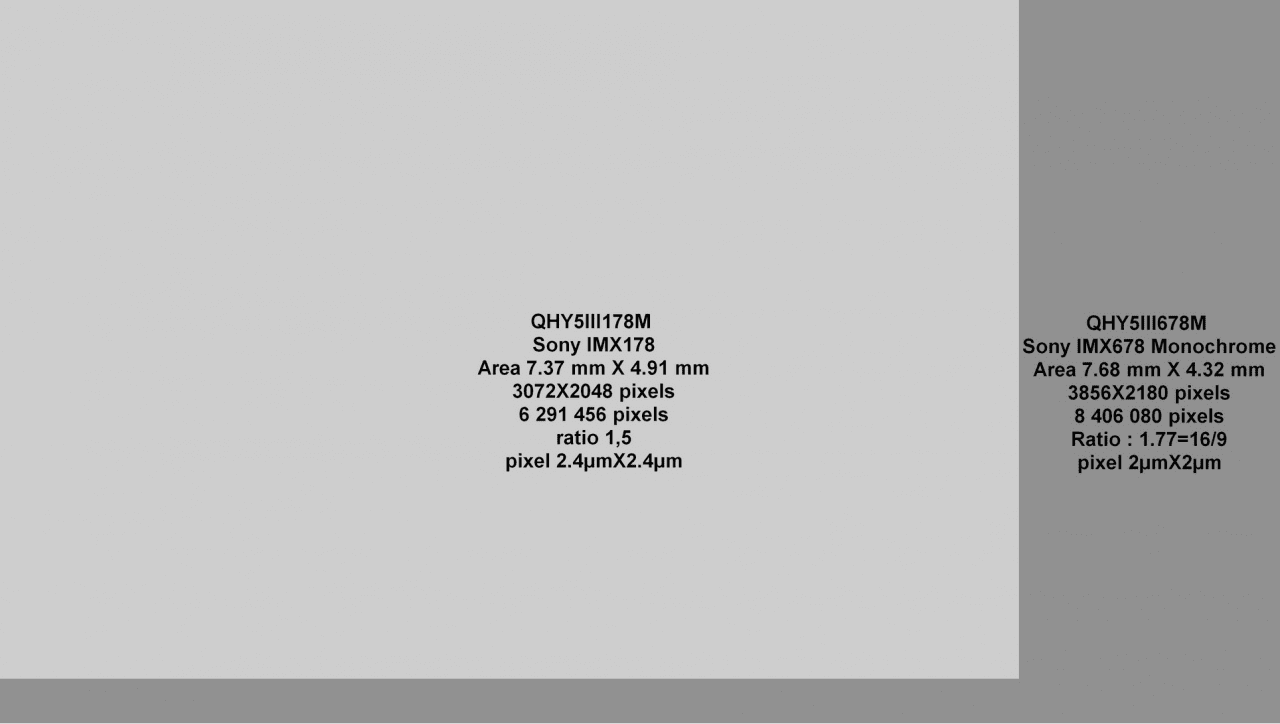 The 178 M equipped with the Sony CMOS IMX178 STARVIS modified color sensor sometimes caused me to have a visible frame under heavy processing. With the Sony IMX 678 no problem. The QHY5III678M uses the entire usable surface area (3856X2180) unlike other manufacturers. The 178 captures the most light around 480nm while the 678 is between 650 and 715nm. The 678 in the area I use up to 807 nm only loses 14%.
The 178 M equipped with the Sony CMOS IMX178 STARVIS modified color sensor sometimes caused me to have a visible frame under heavy processing. With the Sony IMX 678 no problem. The QHY5III678M uses the entire usable surface area (3856X2180) unlike other manufacturers. The 178 captures the most light around 480nm while the 678 is between 650 and 715nm. The 678 in the area I use up to 807 nm only loses 14%.
If you have to work in the visible band you will need to keep the IR cut filter, even more so if you use the QHY5III678C.
Here are tests with the gain at 0 showing the differences between the two models under 65 lux lighting with a 200mm zoom open to 4.5.
The 678 allows you to gain acquisition speed or lower the gain compared to the 178.
It also offers greater magnification thanks to its smaller pixels, which can allow you to switch to the lower barlow and thus further gain in brightness. The higher we go into the infrared, the greater the difference. I tested in BIN1, BIN 2, the 678 also offers a BIN 4 mode.

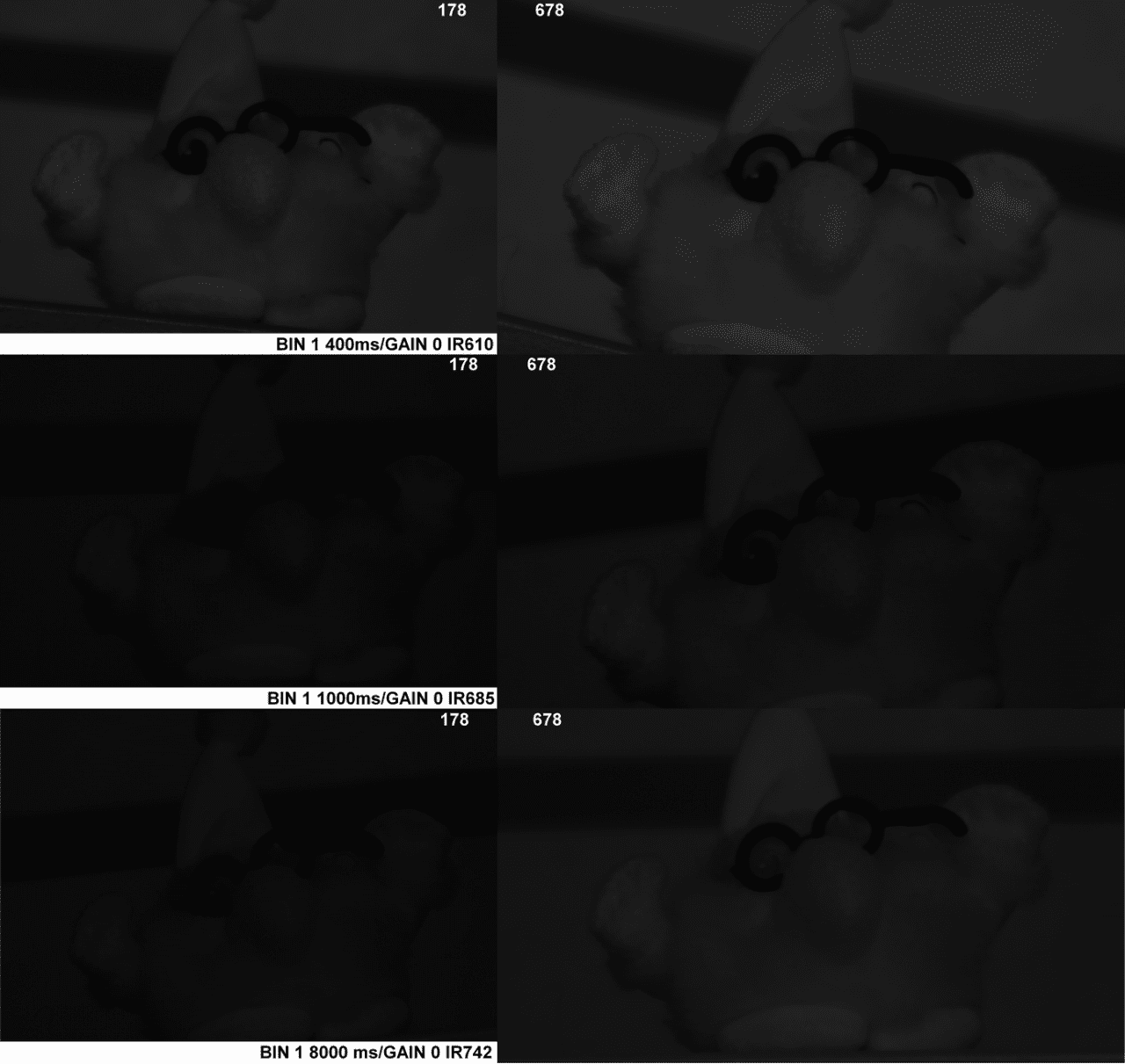
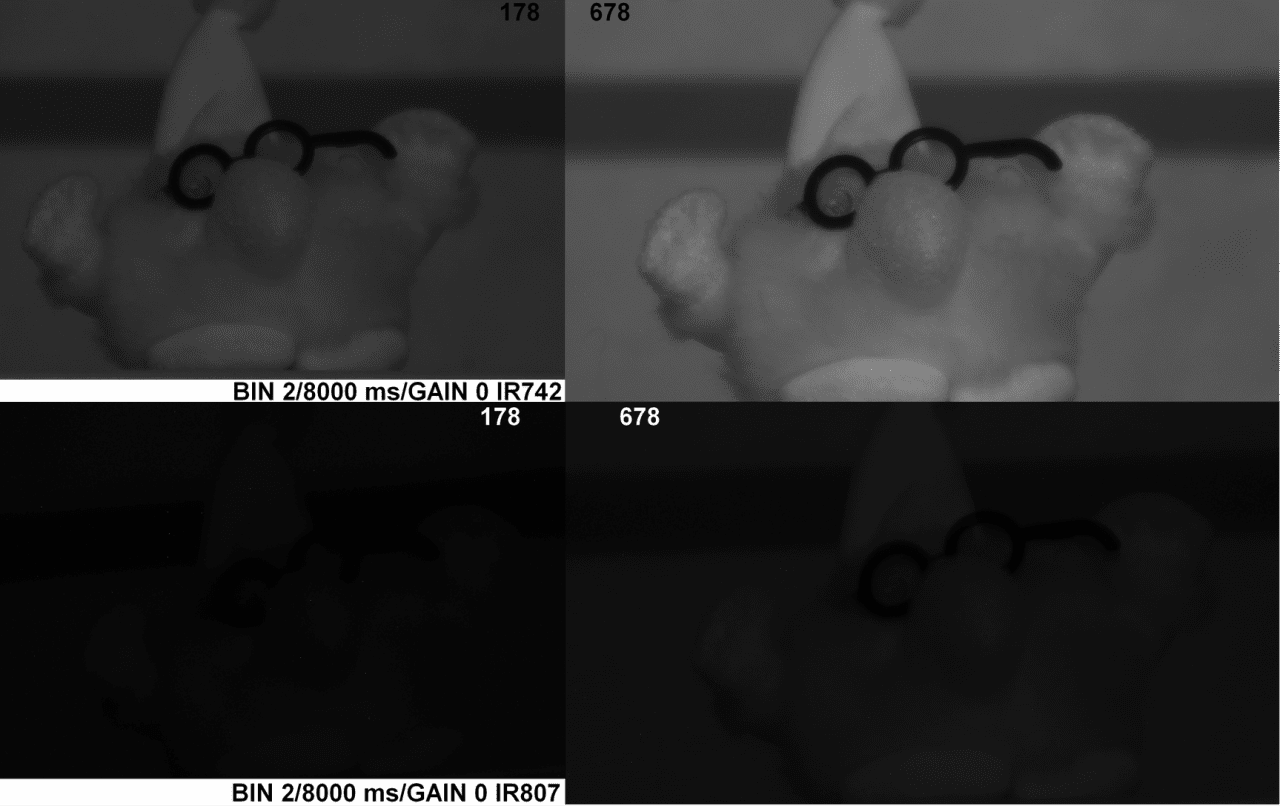 All image dimensions are possible :
All image dimensions are possible :
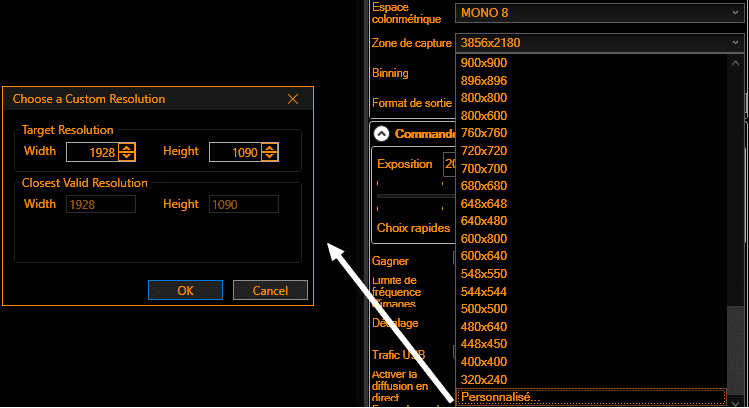 In terms of acquisition speeds with my computer, the promises are kept. Full resolution 8-bit 43 fps.
In terms of acquisition speeds with my computer, the promises are kept. Full resolution 8-bit 43 fps.
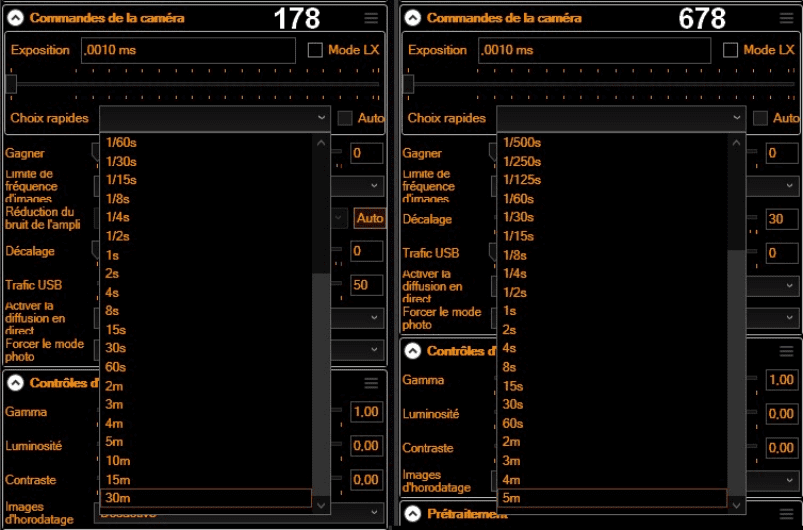 The precision of my equatorial platform only allows me exposures of 3 seconds at most. Not doing deep sky, I show you the speeds allowed by the two cameras with SharpCap. The 178 offers a much longer exposure time. Note that in this software we do not reach the planned 900 seconds, or 15 minutes with the 678.
The precision of my equatorial platform only allows me exposures of 3 seconds at most. Not doing deep sky, I show you the speeds allowed by the two cameras with SharpCap. The 178 offers a much longer exposure time. Note that in this software we do not reach the planned 900 seconds, or 15 minutes with the 678.
At maximum resolution, no dropped images and no buffer up to at least 5000 images in SER on my computer with just SharpCap started.
The 512 MB DD3 buffer present in version 2 is certainly not unrelated to the transmission of this enormous data transmission.
For my use in planetary with a large diameter, this camera gives me more advantages compared to the 178 which are:
Easy installation with the software I use.
Absence of artifact because real monochrome sensor.
Larger sensors reduce the number of images in the case of mosaics.
Smaller pixels allow the use of less powerful blows.
Much better sensitivity in infrared to combat turbulence and allow either to reduce the exposure time or the gain.
The number of frames per second is barely lower than 178 despite the greater amount of information transferred to the computer.
Tests by other astronomers show excellent results thanks to the sensitivity in the infrared in solar imaging and we can have excellent results on planets such as Venus on its clouds and for the unilluminated zone in the infrared around 1000 nm and more allowing hot spots to be shown.
Although I haven’t yet had an exceptional night since I received the 678, I have already been able to take images at least equivalent to my best with the 178, which promises for the future.
French text translated into English by software.
Luc CATHALA Mazan 84380 in France. October 23, 2023.
The camera requires an input voltage between 11V and 13.8V. If the input voltage is too low the camera will stop functioning or it may reboot when the TEC power percent is high, causing a drain on the power. Therefore, please make sure the input voltage arrived to the camera is adequate. 12V is the best but please note that a 12V cable that is very long or a cable with small conductor wire may exhibit enough resistance to cause a voltage drop between the power supply and the camera. The formular is: V(drop) = I * R (cable). It is advised that a very long 12V power cable not be used. It is better to place the 12V AC adapter closer to the camera.
First connect the 12V power supply, then connect the camera to your computer via the USB3.0 cable. Make sure the camera is plugged in before connecting the camera to the computer, otherwise the camera will not be recognized. When you connect the camera for the first time, the system discovers the new device and looks for drivers for it. You can skip the online search step by clicking “Skip obtaining the driver software from Windows Update” and the computer will automatically find the driver locally and install it. If we take the 5IIISeries driver as an example (shown below), after the driver software is successfully installed, you will see QHY5IIISeries_IO in the device manager.
Please note that the input voltage cannot be lower than 11.5v, otherwise the device will be unable to work normally.
All-in-one Pack supports most QHYCCD models only except PoleMaster and several discontinued CCD cameras.
Download Page: https://www.qhyccd.com/download/
Video Tutorial: https://www.youtube.com/embed/mZDxIK0GZRc?start=1
Here we mainly take QHY5III462C as example. This User Guide can be applied to all QHY5III series Camera.

Adjust OFFSET. You will find that when the lens cover is closed and the image is completely black, the background of the image is still not completely black. Therefore, you need to adjust the OFFSET value to make the image darker. Generally speaking, for planetary shooting, setting the image background to very dark is not a big problem. For deep space shooting, a certain background should be retained, and it should not be completely black, otherwise it will lead to the loss of a weak background cloud.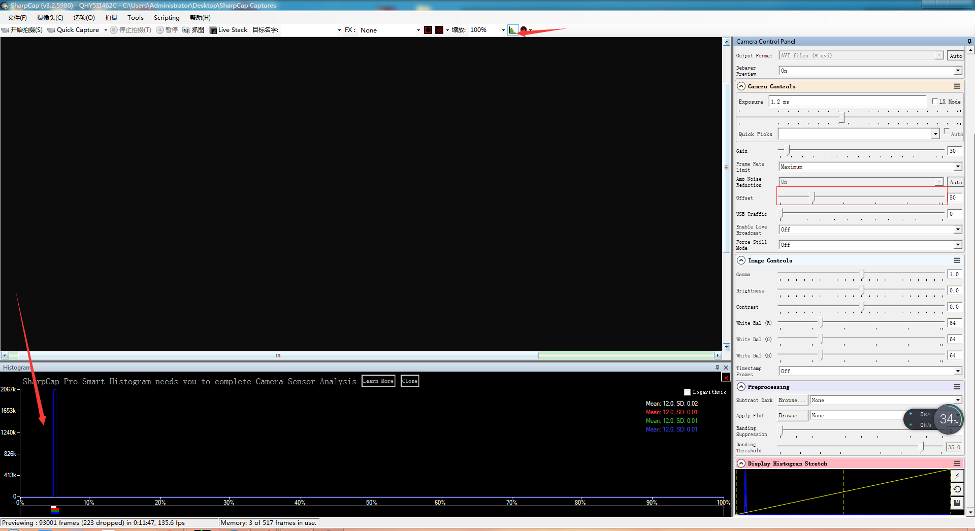
There are many astronomical software support ASCOM, you can connect QHY5III462C through ASCOM. Note that currently QHY5III462C only supports the ordinary ASCOM shooting mode, and does not yet support the ASCOM video mode. In order to obtain the maximum dynamic range and effect, the ASCOM driver uses the maximum number of digits transmission by default (for QHY5III462C, 12-bit), the image is stored in a 16-bit format, and the lower bits are filled with zeros.
Use MAXIMDL for Plantery Imaging
Using PHD for Guiding
Select a star point on the screen, a green frame appears, and then select to start calibrating the equatorial mount and guide star.
QHYCCD BroadCast WDM Camera is a broadcast driver that supports QHYCCD cameras with video broadcast function, which can meet the needs of customers to send video images to other target software. For example, use sharpcap to connect a WDM-enabled camera, and the sharpcap display video image can be sent to other WDM-supported software for display, which is suitable for video online broadcast applications.
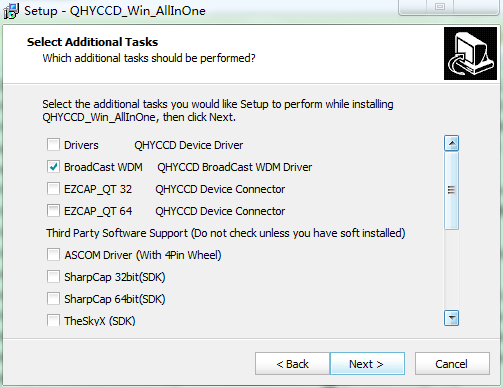
The installation process is over, right-click the computer to find the device manager, and check that the image device name is QHYCCD BroadCast WDM Camera, which means the installation is successful.
QHY5III Guiding Line Sequence Definition
The guide circuit contains an optocoupler isolator. The COMMON pin is generally connected to GND. Usually the four direction pins from the equatorial mount are internally pulled up on the equatorial mount circuit, so when the QHY5III sends out the guide star pulse, the optocoupler pulls it down to realize the output of the guide star command.
The line sequence of the socket at the equatorial mount is
If you use other types of equatorial mounts, please confirm whether the wire sequence is the same as the above.
Because QHY5III series cameras have a very high frame rate and data volume, not all computers can reach the maximum frame rate. Generally I7 quad-core is no problem. However, the CPU occupancy rate will also affect the maximum frame rate, so when using QHY5III, try to close other programs that occupy the CPU and free up the CPU to process the data. If the CPU usage is too high, the program will respond slowly or even crash.
| Cooled CMOS Camera | Bayer |
| QHY600C/QHY268C/QHY410C/
QHY367Pro/QHY128Pro/QHY294C/ QHY247C/QHY168C/QHY165C/QHY183C/QHY174C |
RGGB |
| QHY533C/QHY178C/QHY290C/QHY224C | GBRG |
| QHY163C | GRBG |
| QHY1920C | BGGR |
| Cooled CCD Camera | |
| QHY8L-C | GBRG |
| QHY10-C | RGGB |
| QHY12-C | BGGR |
| Planetary and Guiding | |
| QHY5III174C | RGGB |
| QHY5III178C | GBRG |
| QHY5III224C | GBRG |
| QHY5III290C | GBRG |
| QHY5III462C | GBRG |
| QHY5III485C | RGGB |
| QHY5L-II-C | GRBG |
| QHY5P-II-C | GBRG |
| QHY5III585C | RGGB |
| QHY5III678C | RGGB |
| QHY5III715C | GBRG |
| QHY5III568C | RGGB |
Now the ratio R”:G”=(R+bias)/(2R+bias) and it is not equ to 1:2. It shows the bias will effect the true value of the R:G. And the ratio of R:G will arious when the image light changed. It is hardly to correct with a fixed ratio.
But for DSO capture, You should keep the offset above zero and avoid the background is cut off. A background from 1000-5000 is a good value(16bit mode) for DSO imaging.